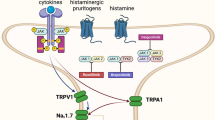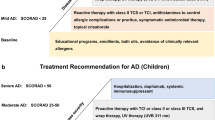Abstract
In this study, we aimed to investigate the effect of electro-acupuncture (EA) at the Zusanli acupoint (ST36) on interleukin (IL)-33-mediated mast cell activation. Firstly, 2,4-dinitrofluorobenzene (DNFB)-induced allergic contact dermatitis (ACD) in rats was developed with or without EA treatment. Then, rat peritoneal mast cells (RPMCs) were obtained and cultured in the presence of IL-33. EA treatment relieved ear swelling and reduced mast cell infiltration in the local inflammation area with DNFB challenge, accompanying the decrement of IL-33 production. RPMCs isolated from ACD rats with EA treatment showed significant downregulation of IL-6, TNF-α, IL-13, and MCP-1 production following IL-33 stimulation. However, there was no obvious difference in surface ST2 receptor expression among different groups. In addition, EA selectively altered IL-33 signaling, suppressing p38 phosphorylation as well as NF-κB- and AP-1-mediated transcription but not Akt phosphorylation. Importantly, EA lowered microRNA (miR)-155 expression in the RPMCs, which presented a positive correlation with IL-33-induced IL-6 production. Furthermore, overexpression of miR-155 in the RPMCs was established following miR-155 mimic transfection. RPMCs with the overexpressed miR-155 displayed an obvious increment of inflammatory cytokine and abrogated the inhibitive effect of EA on NF-κB- and AP-1-regulated transcription in response to IL-33 compared with those without transfected-miR-155. These findings demonstrate EA treatment inhibits NF-κB and AP-1 activation as well as promotes the negative feedback regulation of IL-33 signaling via targeting miR-155 in mast cells, which contribute to the anti-inflammatory effect of EA on DNFB-induced ACD in rats.








Similar content being viewed by others
References
Pawankar, R., Canonica, G.W., Holgate, S.T., and Lockey, R.F. 2012. Allergic diseases and asthma: a major global health concern. Curr Opin Allergy Clin Immunol 12: 39–41.
Kostner, L., F. Anzengruber, C. Guillod, M. Recher, P. Schmid-Grendelmeier, and A.A. Navarini. 2017. Allergic contact dermatitis. Immunology and Allergy Clinics of North America 37: 141–152.
Galli, S.J., and M. Tsai. 2012. IgE and mast cells in allergic disease. Nature Medicine 18: 693–704.
Gaudenzio, N., R. Sibilano, T. Marichal, P. Starkl, L.L. Reber, N. Cenac, B.D. McNeil, X. Dong, J.D. Hernandez, R. Sagi-Eisenberg, I. Hammel, A. Roers, S. Valitutti, M. Tsai, E. Espinosa, and S.J. Galli. 2016. Different activation signals induce distinct mast cell degranulation strategies. The Journal of Clinical Investigation 126: 3981–3998.
Liew, F.Y., J.P. Girard, and H.R. Turnquist. 2016. Interleukin-33 in health and disease. Nature Reviews Immunology 16: 676–689.
Silver, M.R., A. Margulis, N. Wood, S.J. Goldman, M. Kasaian, and D. Chaudhary. 2010. IL-33 synergizes with IgE-dependent and IgE-independent agents to promote mast cell and basophil activation. Inflammation Research 59: 207–218.
Ndaw, V.S., D. Abebayehu, A.J. Spence, P.A. Paez, E.M. Kolawole, M.T. Taruselli, H.L. Caslin, A.P. Chumanevich, A. Paranjape, B. Baker, B.O. Barnstein, T.T. Haque, K.N. Kiwanuka, C.A. Oskeritzian, and J.J. Ryan. 2017. TGF-β1 suppresses IL-33-induced mast cell function. Journal of Immunology 199: 866–873.
Yi, L., D. Cheng, K. Zhang, X. Huo, Y. Mo, H. Shi, H. Di, Y. Zou, H. Zhang, J. Zhao, Y. Xu, D.J. Erle, and G. Zhen. 2017. Intelectin contributes to allergen-induced IL-25, IL-33, and TSLP expression and type 2 response in asthma and atopic dermatitis. Mucosal Immunology 10: 1491–1503.
Komai-Koma, M., F. Brombacher, P.N. Pushparaj, B. Arendse, C. McSharry, J. Alexander, R. Chaudhuri, N.C. Thomson, A.N. McKenzie, I. McInnes, F.Y. Liew, and D. Xu. 2012. Interleukin-33 amplifies IgE synthesis and triggers mast cell degranulation via interleukin-4 in naïve mice. Allergy 67: 1118–1126.
Louten, J., A.L. Rankin, Y. Li, E.E. Murphy, M. Beaumont, C. Moon, P. Bourne, T.K. McClanahan, S. Pflanz, and R. de Waal Malefyt. 2011. Endogenous IL-33 enhances Th2 cytokine production and T-cell responses during allergic airway inflammation. International Immunology 23: 307–315.
Hsu, C.L., C.V. Neilsen, and P.J. Bryce. 2010. IL-33 is produced by mast cells and regulates IgE-dependent inflammation. PLoS One 5: e11944.
Kim, S.K., and H. Bae. 2010. Acupuncture and immune modulation. Autonomic Neuroscience 157: 38–41.
Mori, H., K. Nishijo, H. Kawamura, and T. Abo. 2002. Unique immunomodulation by electro-acupuncture in humans possibly via stimulation of the autonomic nervous system. Neuroscience Letters 320: 21–24.
Wang, Z., T. Chen, M. Long, L. Chen, L. Wang, N. Yin, and Z. Chen. 2017. Electro-acupuncture at Acupoint ST36 ameliorates inflammation and regulates Th1/Th2 balance in delayed-type hypersensitivity. Inflammation 40: 422–434.
Wang, Z., T. Yi, M. Long, Y. Gao, C. Cao, C. Huang, Q. Wang, N. Yin, and Z. Chen. 2017. Electro-acupuncture at Zusanli Acupoint (ST36) suppresses inflammation in allergic contact dermatitis via triggering local IL-10 production and inhibiting p38 MAPK activation. Inflammation 40: 1351–1364.
Muñoz-Cruz, S., Y. Mendoza-Rodríguez, K.E. Nava-Castro, L. Yepez-Mulia, and J. Morales-Montor. 2015. Gender-related effects of sex steroids on histamine release and FcεRI expression in rat peritoneal mast cells. Journal of Immunology Research 2015: 351829.
Zhang, J., K. Huang, G. Zhong, Y. Huang, S. Li, S. Qu, and J. Zhang. 2016. Acupuncture decreases NF-κB p65, miR-155, and miR-21 and increases miR-146a expression in chronic atrophic gastritis rats. Evidence-based Complementary and Alternative Medicine 2016: 9404629.
Modena, B.D., K. Dazy, and A.A. White. 2016. Emerging concepts: mast cell involvement in allergic diseases. Translational Research 174: 98–121.
Saluja, R., M. Khan, M.K. Church, and M. Maurer. 2015. The role of IL-33 and mast cells in allergy and inflammation. Clin Transl Allergy 5: 33.
Hsu, C.L., and P.J. Bryce. 2012. Inducible il-33 expression by mast cells is regulated by a calcium dependent pathway. Journal of Immunology 189: 3421–3429.
Iikura, M., H. Suto, N. Kajiwara, K. Oboki, T. Ohno, Y. Okayama, H. Saito, S.J. Galli, and S. Nakae. 2007. IL-33 can promote survival, adhesion and cytokine production in human mast cells. Lab Invest 87: 971–978.
Wang, J.X., S. Kaieda, S. Ameri, N. Fishgal, D. Dwyer, A. Dellinger, C.L. Kepley, M.F. Gurish, and P.A. Nigrovic. 2014. IL-33/ST2 axis promotes mast cell survival via BCLXL. Proceedings of the National Academy of Sciences of the United States of America 111: 10281–10286.
Savinko, T., S. Matikainen, U. Saarialho-Kere, M. Lehto, G. Wang, S. Lehtimäki, P. Karisola, T. Reunala, H. Wolff, A. Lauerma, and H. Alenius. 2012. IL-33 and ST2 in atopic dermatitis: expression profiles and modulation by triggering factors. The Journal of Investigative Dermatology 132: 1392–1400.
Lott, J.M., T.L. Sumpter, and H.R. Turnquist. 2015. New dog and new tricks: evolving roles for IL-33 in type 2 immunity. Journal of Leukocyte Biology 97: 1037–1048.
Tamagawa-Mineoka, R., Y. Okuzawa, K. Masuda, and N. Katoh. 2014. Increased serum levels of interleukin 33 in patients with atopic dermatitis. Journal of the American Academy of Dermatology 70: 882–888.
Liu, B., Y. Tai, S. Achanta, M.M. Kaelberer, A.I. Caceres, X. Shao, J. Fang, and S.E. Jordt. 2016. IL-33/ST2 signaling excites sensory neurons and mediates itch response in a mouse model of poison ivy contact allergy. Proceedings of the National Academy of Sciences of the United States of America 113: E7572–E7579.
Peng, G., Z. Mu, L. Cui, P. Liu, Y. Wang, W. Wu, and X. Han. 2017. Anti-IL-33 antibody has a therapeutic effect in an atopic dermatitis murine model induced by 2, 4-dinitrochlorobenzene. Inflammation. https://doi.org/10.1007/s10753-017-0673-7.
Chow, J.Y., C.K. Wong, P.F. Cheung, and C.W. Lam. 2010. Intracellular signaling mechanisms regulating the activation of human eosinophils by the novel Th2 cytokine IL-33: implications for allergic inflammation. Cellular & Molecular Immunology 7: 26–34.
Paranjape, A., O. Chernushevich, A.A. Qayum, A.J. Spence, M.T. Taruselli, D. Abebayehu, B.O. Barnstein, J.J. McLeod, B. Baker, G.S. Bajaj, A.P. Chumanevich, C.A. Oskeritzian, and J.J. Ryan. 2016. Dexamethasone rapidly suppresses IL-33-stimulated mast cell function by blocking transcription factor activity. Journal of Leukocyte Biology 100: 1395–1404.
Funakoshi-Tago, M., K. Okamoto, R. Izumi, K. Tago, K. Yanagisawa, Y. Narukawa, F. Kiuchi, T. Kasahara, and H. Tamura. 2015. Anti-inflammatory activity of flavonoids in Nepalese propolis is attributed to inhibition of the IL-33 signaling pathway. International Immunopharmacology 25: 189–198.
Caslin, H.L., J.J.A. McLeod, A.J. Spence, A.A. Qayum, E.M. Kolawole, M.T. Taruselli, A. Paranjape, H.L. Elford, and J.J. Ryan. 2017. Didox (3,4-dihydroxybenzohydroxamic acid) suppresses IL-33-induced cytokine production in primary mouse mast cells. Cellular Immunology 2319: 10–16.
Xiao, C., and K. Rajewsky. 2009. MicroRNA control in the immune system: basic principles. Cell 136: 26–36.
Ma, L., H.B. Xue, F. Wang, C.M. Shu, and J.H. Zhang. 2015. MicroRNA-155 may be involved in the pathogenesis of atopic dermatitis by modulating the differentiation and function of T helper type 17 (Th17) cells. Clinical and Experimental Immunology 181: 142–149.
Zech, A., C.K. Ayata, F. Pankratz, A. Meyer, K. Baudiß, S. Cicko, G.G. Yegutkin, S. Grundmann, and M. Idzko. 2015. MicroRNA-155 modulates P2R signaling and Th2 priming of dendritic cells during allergic airway inflammation in mice. Allergy 70: 1121–1129.
Qayum, A.A., A. Paranjape, D. Abebayehu, E.M. Kolawole, T.T. Haque, J.J. McLeod, A.J. Spence, H.L. Caslin, M.T. Taruselli, A.P. Chumanevich, B. Baker, C.A. Oskeritzian, and J.J. Ryan. 2016. IL-10-induced miR-155 targets SOCS1 to enhance IgE-mediated mast cell function. Journal of Immunology 196: 4457–4467.
Elmesmari, A., A.R. Fraser, C. Wood, D. Gilchrist, D. Vaughan, L. Stewart, C. McSharry, I.B. McInnes, and M. Kurowska-Stolarska. 2016. MicroRNA-155 regulates monocyte chemokine and chemokine receptor expression in rheumatoid arthritis. Rheumatology (Oxford) 55: 2056–2065.
Malmhäll, C., S. Alawieh, Y. Lu, M. Sjöstrand, A. Bossios, M. Eldh, and M. Rådinger. 2014. MicroRNA-155 is essential for T(H)2-mediated allergen-induced eosinophilic inflammation in the lung. The Journal of Allergy and Clinical Immunology 133: 1429–1438.
Biethahn, K., Z. Orinska, E. Vigorito, D.A. Goyeneche-Patino, F. Mirghomizadeh, N. Föger, and S. Bulfone-Paus. 2014. miRNA-155 controls mast cell activation by regulating the PI3Kγ pathway and anaphylaxis in a mouse model. Allergy 69: 752–762.
Johansson, K., C. Malmhäll, P. Ramos-Ramírez, and M. Rådinger. 2017. MicroRNA-155 is a critical regulator of type 2 innate lymphoid cells and IL-33 signaling in experimental models of allergic airway inflammation. The Journal of Allergy and Clinical Immunology 139: 1007–1016.
Liu, Y., H. Wang, X. Wang, L. Mu, Q. Kong, D. Wang, J. Wang, Y. Zhang, J. Yang, M. Zhou, G. Wang, B. Sun, and H. Li. 2013. The mechanism of effective electroacupuncture on T cell response in rats with experimental autoimmune encephalomyelitis. PLoS One 8: e51573.
Torres-Rosas, R., G. Yehia, G. Peña, P. Mishra, M. del Rocio Thompson-Bonilla, M.A. Moreno-Eutimio, L.A. Arriaga-Pizano, A. Isibasi, and L. Ulloa. 2014. Dopamine mediates vagal modulation of the immune system by electroacupuncture. Nature Medicine 20: 291–295.
Cabioğlu, M.T., and B.E. Cetin. 2008. Acupuncture and immunomodulation. The American Journal of Chinese Medicine 36: 25–36.
Zhou, W., and P. Benharash. 2014. Effects and mechanisms of acupuncture based on the principle of meridians. Journal of Acupuncture and Meridian Studies 7: 190–193.
Acknowledgments
This work was supported by the grants from the Specialized Fund of Hubei Provincial Department of Education in Hubei Provincial Collaborative Innovation Center of Preventive Treatment by Acupuncture and Moxibustion (No. HBPCIC-2016-020) and Natural Science Foundation of Hubei Province of China (No. 2015CFA096).
Author information
Authors and Affiliations
Contributions
Zhigang Wang, Tao Yi, and Zebin Chen designed the study; Zhigang Wang and Tao Yi performed the experiment and wrote the manuscript; Man Long contributed to the rat model; Fengmin Ding analyzed the data; and Lichen Ouyang and Zebin Chen helped to revise the manuscript.
Corresponding author
Ethics declarations
All experiments were performed according to the standard of the Animal Care and Use Committee of Hubei University of Chinese Medicine concerning the Care and Use of Laboratory Animals (No. SYXK2012-0067).
Conflict of Interest Statement
The authors declare that they have no conflicts of interest.
Rights and permissions
About this article
Cite this article
Wang, Z., Yi, T., Long, M. et al. Involvement of the Negative Feedback of IL-33 Signaling in the Anti-Inflammatory Effect of Electro-acupuncture on Allergic Contact Dermatitis via Targeting MicroRNA-155 in Mast Cells. Inflammation 41, 859–869 (2018). https://doi.org/10.1007/s10753-018-0740-8
Published:
Issue Date:
DOI: https://doi.org/10.1007/s10753-018-0740-8




